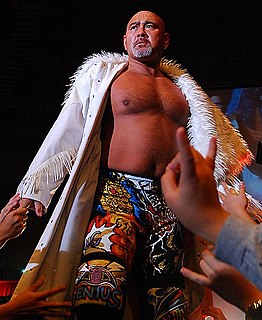
Keiji Muto is a Japanese professional wrestler and professional wrestling executive currently signed to Pro Wrestling Noah (Noah), where he is a former GHC Heavyweight Champion. He is best known for his work as The Great Muta in World Championship Wrestling (WCW) and New Japan Pro-Wrestling (NJPW) during the 1980s and 1990s, and from his runs in other American, Puerto Rican, and Mexican promotions. He was the president of All Japan Pro Wrestling (AJPW) from 2002 to 2013 and representative director of Wrestle-1 (W-1) from 2013 to 2020.

Masahiro "Masa" Chono is an American-born Japanese-American retired professional wrestler and actor best known for his 26 year stint with New Japan Pro-Wrestling (NJPW). As the leader of nWo Japan, Team 2000 and Black New Japan, he was the promotion's top heel for much of his career, beginning in 1994 when he adopted his Yakuza inspired gimmick.

Genichiro Shimada, better known as Genichiro Tenryu is a retired Japanese professional wrestler and professional wrestling promoter. At age 13, he entered sumo wrestling and stayed there for 13 years, after which he turned to Western-style professional wrestling. "Tenryu" was his shikona. He had two stints with All Japan Pro Wrestling (AJPW), where he spent the majority of his career while also promoting Super World of Sports (SWS), Wrestle Association R (WAR) and Tenryu Project. At the time of his retirement, professional wrestling journalist and historian Dave Meltzer wrote that "one could make a strong case [that Tenryu was] between the fourth and sixth biggest native star" in the history of Japanese professional wrestling.
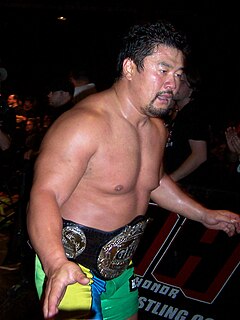
Kensuke Sasaki is a Japanese retired professional wrestler, mixed martial artist, and founder of the now-defunct wrestling promotion Diamond Ring.

Hiroshi Hase is a Japanese politician who is currently the governor of Ishikawa Prefecture. He served as the Minister of Education, Culture, Sports, Science and Technology under Prime Minister Shinzō Abe. Prior to his appointment in the Cabinet, he also served as a member of the House of Representatives of the National Diet, representing the 1st district of Ishikawa Prefecture.
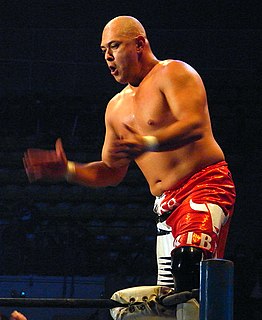
Maunakea Mossman is an American semi-retired professional wrestler, better known under his stage name Taiyō Kea (太陽ケア). He is the only wrestler to have held the Triple Crown Heavyweight Championship, the World Tag Team Championship and the World Junior Heavyweight Championship.
Tatsutoshi Goto is a Japanese professional wrestler. He competed primarily in WAR and New Japan Pro-Wrestling (NJPW), and briefly used the name "T2000 Machine". He also briefly competed in World Championship Wrestling (WCW) as part of the nWo Japan.
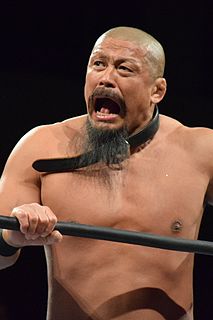
Takayuki Iizuka, better known by his ring name Takashi Iizuka, is a Japanese retired professional wrestler. He is best known for his 33-year career in New Japan Pro-Wrestling (NJPW), where he was a three-time IWGP Tag Team Champion. He has also worked for Pro Wrestling Noah, where he was a one-time GHC Tag Team Champion.

Shiro Koshinaka is a Japanese professional wrestler who has competed in All Japan Pro Wrestling (AJPW), New Japan Pro-Wrestling (NJPW) and Wrestle Association "R" (WAR) during the 1980s and 1990s. He was also the first IWGP Junior Heavyweight Champion.

Tadao Yasuda is a Japanese retired sumo wrestler (rikishi), professional wrestler and mixed martial artist. He competed in sumo from 1979 to 1992 under the shikona of Takanofuji Tadao, achieving the rank of komusubi, and afterwards turned to professional wrestling, in which he competed from 1994 to 2011, most notably in New Japan Pro-Wrestling (NJPW), where he was a one-time IWGP Heavyweight Champion. He was also fought in mixed martial arts from 2001 to 2003, holding a notable win over Jérôme Le Banner.
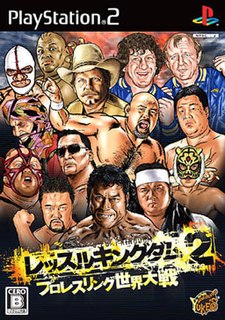
Wrestle Kingdom 2: Pro Wrestling Sekai Taisen is a professional wrestling video game for the PlayStation 2. It is the sequel to Yuke's Wrestle Kingdom.
Cho-Ten was a professional wrestling team that competed in New Japan Pro-Wrestling on and off from February 1995 - September 2006. The team consisted of Masahiro Chono and Hiroyoshi Tenzan. Cho-Ten is one of the most decorated and successful tag teams in New Japan history. They held the IWGP Tag Team Championship five times and won the 1995 Super Grade Tag League.
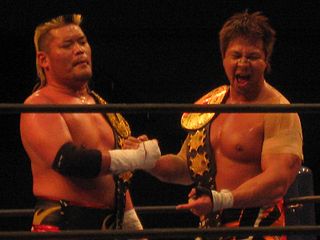
Tencozy is a professional wrestling tag team that has competed in New Japan Pro-Wrestling and All Japan Pro Wrestling. They are seven-time tag team champions. In their history, Tencozy currently hold the second longest IWGP Tag Team Championship reign and are currently the first and only team to have won both the G1 Tag League and World's Strongest Tag Determination League in general and in the same year (2008).
Black New Japan was a professional wrestling stable that competed in New Japan Pro-Wrestling. Black New Japan was led by Masahiro Chono and was one of many of Chono's anti-New Japan stables.
Team 2000 was a professional wrestling stable that competed in New Japan Pro-Wrestling. Throughout its tenure, T2000 was New Japan's top heel stable.
The Mad Dogs were a professional wrestling tag team that consisted of Tatsutoshi Goto and Michiyoshi Ohara. The team competed in New Japan Pro-Wrestling and WAR and were members of several stables including Heisei Ishingun, nWo Japan, and Team 2000.
The tag team of Mike Barton and Jim Steele was a professional wrestling tag team that competed in several puroresu promotions including All Japan Pro Wrestling and New Japan Pro-Wrestling.

Wrestling World 2000 was a professional wrestling event produced by New Japan Pro-Wrestling (NJPW). It took place on January 4, 2000 in the Tokyo Dome. Wrestling World 2000 was the ninth January 4 Tokyo Dome Show held by NJPW. The show drew 53,500 spectators and $5,900,000 in ticket sales. The event saw the return of World Championship Wrestling's Chris Benoit under the ring name Wild Pegasus, reprising the character he played for NJPW in the early to mid-1990s. The show also featured Rick Steiner and Randy Savage, both working as freelancers brought in specifically for the show. The twelve match card saw a successful defense of the IWGP Junior Heavyweight Tag Team Championship and the IWGP Junior Heavyweight Championship as well as Kensuke Sasaki defeating Genichiro Tenryu to win the IWGP Heavyweight Championship. The undercard featured a match between Masahiro Chono defeated Keiji Mutoh bearing a stipulation that the losing wrestler's faction would have to disband. Chono represented Team 2000, while Mutoh represented nWo Japan. Through Mutoh's loss nWo Japan ceased to be. It also featured the retirement match of Kazuo Yamazaki, as he wrestled his student, Yuji Nagata.

Jingu Climax: Battle of Last Summer was a major professional wrestling event produced by New Japan Pro-Wrestling (NJPW). It took place on August 28, 1999 at the Meiji Jingu Stadium in Tokyo, Japan and was televised live on TV Asahi.

Final Dome was a major professional wrestling event produced by New Japan Pro-Wrestling (NJPW). It took place on October 12, 1999 at the Tokyo Dome in Tokyo, Japan and was televised live on TV Asahi.